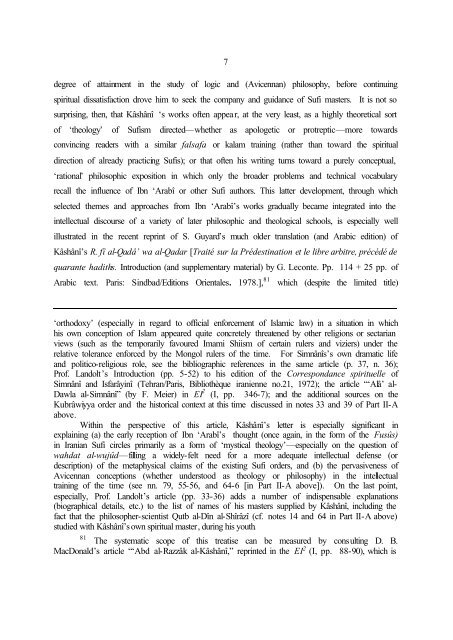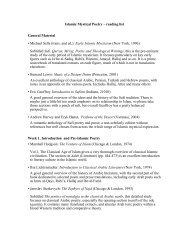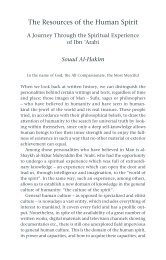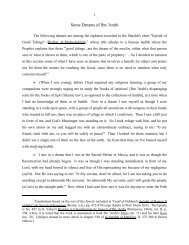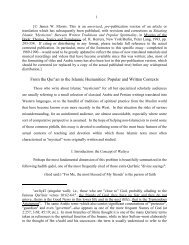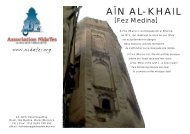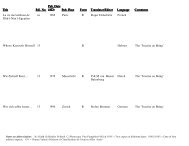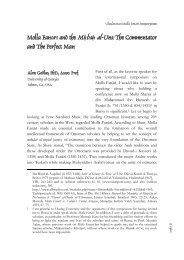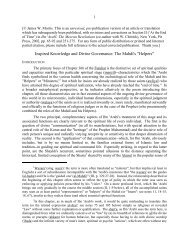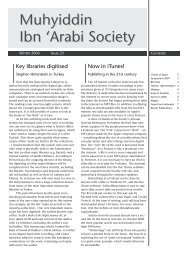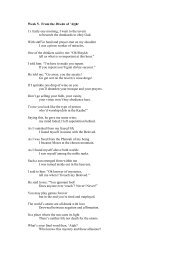Part III (pdf) - Muhyiddin Ibn Arabi Society
Part III (pdf) - Muhyiddin Ibn Arabi Society
Part III (pdf) - Muhyiddin Ibn Arabi Society
Create successful ePaper yourself
Turn your PDF publications into a flip-book with our unique Google optimized e-Paper software.
7degree of attainment in the study of logic and (Avicennan) philosophy, before continuingspiritual dissatisfaction drove him to seek the company and guidance of Sufi masters. It is not sosurprising, then, that Kâshânî ‘s works often appear, at the very least, as a highly theoretical sortof ‘theology’ of Sufism directed—whether as apologetic or protreptic—more towardsconvincing readers with a similar falsafa or kalam training (rather than toward the spiritualdirection of already practicing Sufis); or that often his writing turns toward a purely conceptual,‘rational’ philosophic exposition in which only the broader problems and technical vocabularyrecall the influence of <strong>Ibn</strong> ‘Arabî or other Sufi authors. This latter development, through whichselected themes and approaches from <strong>Ibn</strong> ‘Arabî’s works gradually became integrated into theintellectual discourse of a variety of later philosophic and theological schools, is especially wellillustrated in the recent reprint of S. Guyard’s much older translation (and <strong>Arabi</strong>c edition) ofKâshânî’s R. fî al-Qadâ’ wa al-Qadar [Traité sur la Prédestination et le libre arbitre, précédé dequarante hadiths. Introduction (and supplementary material) by G. Leconte. Pp. 114 + 25 pp. of<strong>Arabi</strong>c text. Paris: Sindbad/Editions Orientales. 1978.], 81 which (despite the limited title)‘orthodoxy’ (especially in regard to official enforcement of Islamic law) in a situation in whichhis own conception of Islam appeared quite concretely threatened by other religions or sectarianviews (such as the temporarily favoured Imami Shiism of certain rulers and viziers) under therelative tolerance enforced by the Mongol rulers of the time. For Simnânîs’s own dramatic lifeand politico-religious role, see the bibliographic references in the same article (p. 37, n. 36);Prof. Landolt’s Introduction (pp. 5-52) to his edition of the Correspondance spirituelle ofSimnânî and Isfarâyinî (Tehran/Paris, Bibliothèque iranienne no.21, 1972); the article “‘Alâ’ al-Dawla al-Simnânî” (by F. Meier) in EI 2 (I, pp. 346-7); and the additional sources on theKubrâwiyya order and the historical context at this time discussed in notes 33 and 39 of <strong>Part</strong> II-Aabove.Within the perspective of this article, Kâshânî’s letter is especially significant inexplaining (a) the early reception of <strong>Ibn</strong> ‘Arabî’s thought (once again, in the form of the Fusûs)in Iranian Sufi circles primarily as a form of ‘mystical theology’—especially on the question ofwahdat al-wujûd—filling a widely-felt need for a more adequate intellectual defense (ordescription) of the metaphysical claims of the existing Sufi orders, and (b) the pervasiveness ofAvicennan conceptions (whether understood as theology or philosophy) in the intelectualtraining of the time (see nn. 79, 55-56, and 64-6 [in <strong>Part</strong> II-A above]). On the last point,especially, Prof. Landolt’s article (pp. 33-36) adds a number of indispensable explanations(biographical details, etc.) to the list of names of his masters supplied by Kâshânî, including thefact that the philosopher-scientist Qutb al-Dîn al-Shîrâzî (cf. notes 14 and 64 in <strong>Part</strong> II-A above)studied with Kâshânî’s own spiritual master, during his youth.81The systematic scope of this treatise can be measured by consulting D. B.MacDonald’s article “‘Abd al-Razzâk al-Kâshânî,” reprinted in the EI 2 (I, pp. 88-90), which is


